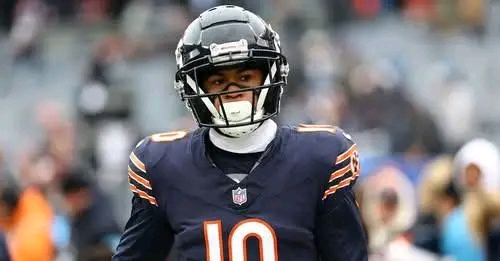Tyler Scott’s Uphill Battle: Can He Secure a Roster Spot with the 2025 Chicago Bears?
LAKE FOREST, Ill. – The Chicago Bears are embarking on a new era defined by high expectations and a relentless pursuit of perfection under head coach Ben Johnson. With franchise quarterback Caleb Williams leading a significantly revamped offense, every roster spot is under intense scrutiny. For third-year wide receiver Tyler Scott, the future with the Bears appears to be an increasingly uphill battle.
According to analysis from Bill Zimmerman of Windy City Gridiron, Scott faces formidable challenges in securing a place on the 2025 roster, as the team’s enhanced talent pool and Johnson’s demanding philosophy leave little room for error or inconsistency.

Tyler Scott entered the NFL with considerable promise. Drafted by the Bears in the fourth round of the 2023 NFL Draft (133rd overall), there was widespread excitement about his potential. Experts had often projected him to be a second or third-round pick, making his selection in the fourth round seem like a steal for then-General Manager Ryan Poles. Scott’s collegiate career at the University of Cincinnati showcased notable speed and versatility, attributes the Bears hoped would seamlessly translate to the professional level and provide a dynamic vertical threat.
However, Scott’s first two seasons in the NFL have been a study in diminishing returns. In his rookie year (2023), while his elite speed was evident, struggles with consistently holding onto the football, both as a receiver and in potential return roles, plagued his performance. He logged 439 offensive snaps, recording 17 receptions for 168 yards, and also had 55 special teams snaps. Unfortunately, the struggles in those crucial areas led to a significantly reduced role in his sophomore season (2024).
Scott’s offensive snap count plummeted to a mere 20, and his receiving production dwindled to just one reception for five yards across 11 games played. He was a healthy scratch in multiple contests, indicating a clear decline in his standing within the team’s offensive plans. On special teams, his snaps also decreased to 35. While he did serve as the Bears’ kick returner in Weeks 16-18, accumulating eight returns for 207 yards with a long of 36 yards, this late-season cameo was not enough to offset his overall limited impact.
As the Chicago Bears head into 2025, the competition in the wide receiver room is fiercer than ever, directly impacting Scott’s path to a roster spot. The team boasts an impressive trio at the top of the depth chart: veteran Pro Bowler D.J. Moore, second-year rising star Rome Odunze, and rookie Luther Burden III, drafted high in the 2025 class. Bill Zimmerman unequivocally states that there is “no way Scott can be considered for one of the team’s top three spots,” given the talent and investment in these players.
The next hurdle for Scott comes at the WR4 position, currently projected to be held by veteran Olamide Zaccheaus. Zimmerman highlights Zaccheaus’s consistent contributions in his previous stops, noting that he typically played between 40% and 70% of offensive snaps and approximately 25% of special teams snaps.
This dual threat of reliable offensive production and special teams versatility makes Zaccheaus a strong contender for the fourth wide receiver slot, a position Scott is unlikely to unseat.
Beyond the clear top four, Scott enters a direct competition for what would likely be the fifth or potentially sixth wide receiver spot on the 53-man roster. This is where his biggest challenges lie. Devin Duvernay, signed by the Bears, is a two-time Pro Bowl return specialist, instantly solidifying the kick and punt return duties. This directly clashes with the role Scott briefly held at the end of the 2024 season and removes a primary path to the roster.
Zimmerman points out that if the Bears, under Ben Johnson’s offensive scheme, opt to carry only five wide receivers – a strong possibility given the expected heavy use of 12 personnel (two tight ends, like Cole Kmet and rookie Colston Loveland) – Scott’s chances become even slimmer. If they do decide to keep a sixth receiver, Zimmerman argues that Miles Boykin, with his superior special teams skills as a “gunner-type of player,” would have a stronger case for a spot over Scott.
Zimmerman’s assessment hinges significantly on Scott’s glaring deficiencies on special teams. For players vying for the lower end of the 53-man roster, proficiency on special teams is often a non-negotiable requirement. Whether it’s excelling as a return specialist or contributing as a gunner on coverage units, these roles are crucial for roster flexibility. Scott’s struggles in consistently fielding kicks and punts in 2023, coupled with his limited impact as a gunner, severely undermine his value in this critical phase of the game. If a wide receiver cannot consistently contribute on special teams, they must be, at minimum, a top-four offensive option, a category Scott no longer fits.
Scott’s primary asset remains his electrifying speed. His reported 4.4-second 40-yard dash time and exceptional acceleration make him a potential “take the top off a defense” threat. The Bears’ new offensive scheme under Ben Johnson, which prioritizes high-efficiency plays and maximizing Expected Points Added (EPA), could theoretically benefit from a true vertical stretcher.
However, as Zimmerman succinctly puts it, to be effective in this role, Scott “has to be able to reliably catch the football.” His ongoing issues with drops have directly impacted his ability to earn the opportunities necessary to showcase his deep-threat capabilities and, by extension, secure a roster spot. The potential is there, but the execution has been inconsistent.
In conclusion, the future for Tyler Scott with the Chicago Bears appears precarious. While his initial draft capital and elite speed offered exciting possibilities, his statistical regression in 2024 and the influx of high-caliber talent at the wide receiver position have created an incredibly challenging landscape.
Bill Zimmerman’s analysis paints a clear picture of the uphill battle Scott faces, primarily due to the established talent ahead of him, the emphasis on two-tight end sets potentially limiting receiver spots, and crucially, his struggles on special teams. For Scott to defy these odds, he would need a truly breakout performance in training camp, demonstrating a dramatic improvement in consistency as both a receiver and a special teams contributor.
Without such a leap, it is, as Zimmerman suggests, “hard to imagine he finds an expanded role in 2025 and will very likely not be on the roster come September.” The competitive fire ignited by Coach Ben Johnson demands perfection, and Tyler Scott is now on the clock to prove he can meet that exacting standard.

